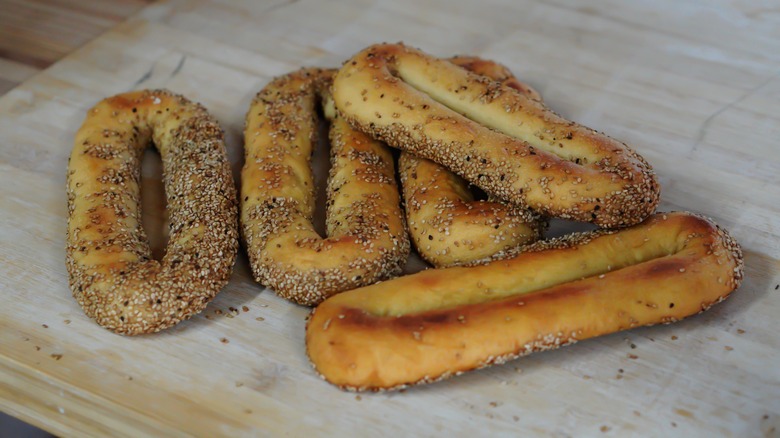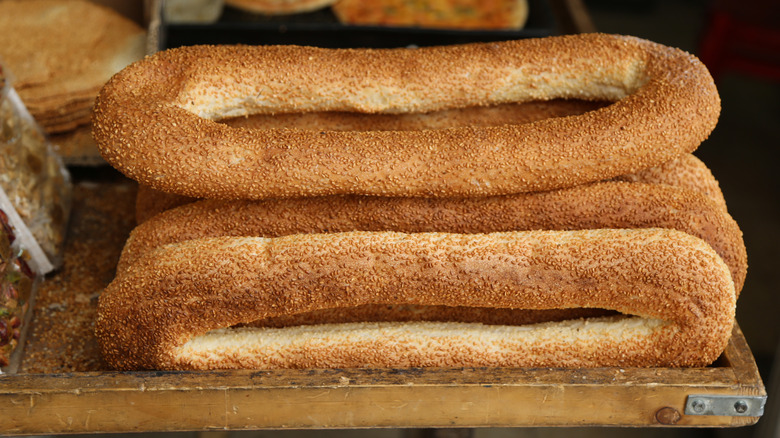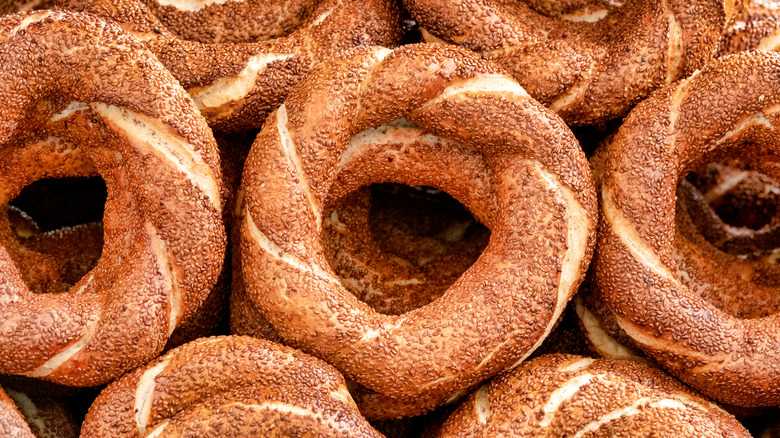Ka'ak: The Arabic Bread You Should Know
A bagel is the perfect breakfast food, and that's as close to a fact as you can get in the world of taste. Just consider its versatility. A bagel can be a bare-bones snack: topped with just cream cheese or maybe sent on a quick trip to the toaster before meeting up with some butter. On the other hand, a bagel can be a serious meal when done up New-York style (that's with smoked salmon, cream cheese, tomatoes, onions, and capers, per Streetwise New York). You'd be hard-pressed to find someone who doesn't like at least one style of bagel, and their popularity has come with significant historical interest.
Bagels were introduced to the United States in the late 1800s by predominantly Jewish immigrants from Eastern Europe, with Smithsonian Magazine noting that bagels are mentioned in written records from Krakow, Poland, dating back to 1610. However, the bagel's story likely begins much earlier than that. Per The Atlantic, some believe bagels were inspired by a similarly-shaped bread called obwarzanek, which came to Poland through a wave of German immigration in the 1300s. A more recent theory, posed by Reem Kassis of Serious Eats, suggests bagels may be descendants of an even older type of bread called ka'ak.
What is ka'ak?
'Ka'ak' is actually an umbrella term for baked goods, coming from the classical Arabic 'kaak,' which means 'cake,' per 196 Flavors. However, the word also refers to a specific type of bread with a hole in the middle and a sesame topping. It is popular throughout the Levant, where it may take slightly different shapes. In Lebanon and Jordan, it is made in a teardrop shape with a hole near the narrow end, such that the bread almost looks like a purse. The Israeli style, known as 'ka'ak al quds,' or 'Jerusalem bread,' is shaped like a bagel, sometimes elongated.
Ka'ak is popular street food in the Levant, and you'll often find them at carts, hanging from the rails by their central holes (via Taste Atlas). The Lebanese variety is sometimes stuffed with a variety of fillings, common examples including picon cheese and za'atar, a spice blend containing thyme, sumac, and more sesame seeds. Per Taste Atlas, yogurt and cheese are common accompaniments.
Did ka'ak inspire bagels?
Reem Kassis theorizes that ka'ak inspired the original Polish bagels. In a 2021 interview with NPR, the Palestinian cookbook author explained that her theory arose while she read a 13th-century Arab cookbook and found a recipe for ring-shaped ka'ak that called for the dough to be boiled before baking, a traditional step of bagel making not typically used for ka'ak. She wondered if the two were related and uncovered interesting historical ties. Writing for Serious Eats, Kassis notes that previous histories have credited the introduction of bagels to Krakow to a woman named Bona Sforza, who married into Polish royalty in 1518. Sforza came from the Italian city of Bari, which was temporarily under Arab rule in the ninth century. She suggests the Arab influence on Bari's history could have brought ka'ak, or something like it, into Bona Sforza's life, noting that Bari is the home of tarallo, a type of boiled, ring-shaped bread similar to bagels.
There are gaps in Kassis's theory, the most notable being that Bona Sforza did not arrive in Krakow until the 1500s, but the similar obwarzanek is mentioned in Polish writing as early as 1394, something Kassis acknowledges in Serious Eats but doesn't rectify with her theory. More parties will need to get involved in research to prove anything. Kassis makes one very compelling point, though. All along ancient Arab trade routes from Italy to China, we find cultures that enjoy some kind of ring-shaped bread.


